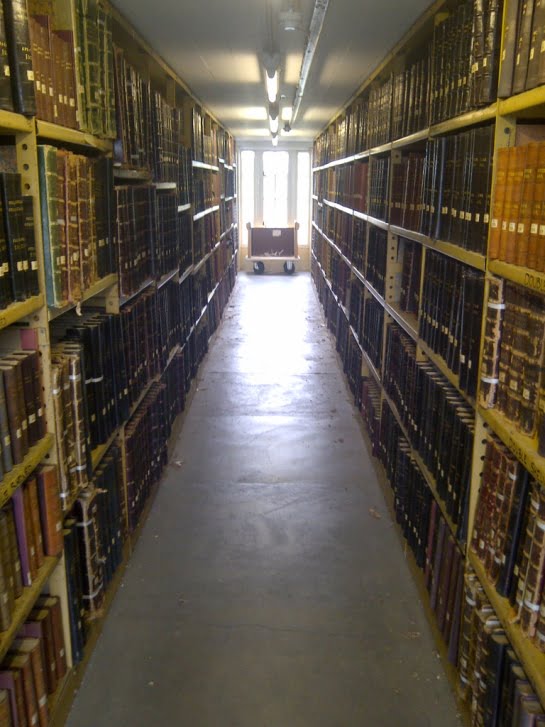
The national newspaper collection is on the move. Next month, the British Newspaper Library – part of the British Library – will be leaving Colindale, north London, its home since 1932. Countless researchers have made use of the Colindale reading rooms over the past eighty years, and it is held in great affection, but few I think would disagree that the place was coming to the end of its natural life. Little changed architecturally from the 1930s, the place has an antique charm, with large volume newspapers being wheeled on venerable trolleys to researchers seated at vintage tables, the very embodiment of libraries from another age. The fixtures and fittings, like the bound newspapers themselves, shedding bits of leather and fragments of fading newsprint, belong to a time when the word digital might only refer to the use of fingers to leaf carefully through the pages. Though there are microfilms readers, and an annexe to the original reading room which is of more modern design, the Colindale library looks and feels as though time has passed it by.
The time for change has now come. The British Library has been engaged in a huge newspaper programme over the past few years, designed to safeguard the nation’s newspaper heritage long term. This programme has included building a new Newspaper Storage Building at Boston Spa in Yorkshire, digitising some 40 million pages (7 million done so far) and making these available online via the British Newspaper Archive site, closing down the Colindale library, and opening a new reading room at the Library’s main site in St Pancras, central London. The intention is to keep the newspapers in optimum storage conditions with carefully controlled temperature and humidity at Boston Spa, such as Colindale does not provide. Researchers will be provided with microfilm and digital ‘surrogates’ at St Pancras. This should serve most needs, but where no surrogate copy exist it will still be possible request the print originals from Boston Spa; so long as they are in good enough condition to travel, they will be delivered delivered to St Pancras within 48 hours.
The Colindale library closes to the public on 8 November 2013, with the new reading room opening in 2014. Many researchers have been making special trips to Colindale to sample its particular research experience for one last time. What none will see, however, is how things look behind the scenes. On six long floors, with assorted adjoining areas, the national newspaper and periodical collection stretches on and on and on. The numbers are mind-boggling – 660,000 bound or boxed volumes, 630,000 microfilms, around 100 million individual issues, 750 million pages, 50 kilometres of shelving.
Being newly appointed as the news curator, I was privileged to walk along that shelving recently, and decided to make a photographic record. Already the shelves are not as full as they once were: the periodicals have largely gone already, and the newspapers are being readied for transportation. But still volume after volume after volume stands in neat order, a monument to the irrepressible human urge to write things down, to communicate with one another, and to identify themselves by occupation, interest and place.
The sheer size of some of the bound volumes astonishes. It’s a major engineering undertaking simply to take some of them off the shelves. The hugeness of such newspapers indicates a time when the majesty of the press was reflected in the way it occupied the entirety of the breakfast table. The tabloid press of today denotes a more hurried age, when the newspaper has to fight for the reader’s attention amid so many other compact, diverting attractions. And as the newspaper goes digital so does its special identity get swallowed up in a forest of apps, games, programmes, tools and assorted entertainments. The news is no longer weighty; it now flits from platform to platform, anxious to please, uncertain of its survival.
The Library’s newspaper collection goes back to the seventeenth century and the birth of the newspaper itself. Systematic collecting did not begin until 1822 (earlier newspapers come from private collections donated to the British Museum). Publishers were obliged to supply copies of every newspaper they published to the Stamp Office for the purposes of taxation. These copies were transferred to the British Museum, until 1869 when newspapers were included in legal deposit legislation and were thereafter sent directly to the Museum. That process of donation under legislation continues to this day, with each issue of just under 2,000 UK and Irish newspaper and weekly or fortnightly periodical titles received per year. In times past they were bound in volumes (just think of the years of industry involved in managing the binding alone of the British newspaper collection); now they are collected in boxes. The collection grows at just under 300 metres per year.
To wander up and down the shelves to is witness the nations and regions of the United Kingdom talking earnestly, passionately and insistently to one another, witness to democracy, debate, conviction and modernity. All of the great national titles are there – The Times, The Guardian, the Daily Telegraph, the News of the World – but also mile upon mile of the regional press, especially prominent in its nineteenth century heyday, when news of the nation and of the world beyond could be found just as readily in your local paper as in the national titles, and when such titles spoke with the voice of Victorian confidence and authority.
The Birmingham Journal & General Advertiser, The Leeds Intelligencer, The Poor Man’s Guardian, The Dundee Courier, The Elgin Courant and Morayshire Advertiser, The Sunderland Daily Echo and Shipping Gazette, The Salopian Journal, The Northampton Mercury, The Lincolnshire Chronicle, The Exeter and Plymouth Gazette Daily Telegrams, The Hartlepool Mail,The Rochester and Chatham Miscellany, Domestic Friend, and General Advertiser …
The newspaper volumes have a weighty beauty about them, even those with more modern bindings that lead to uniform colour and well-regimented order. But the rows upon rows of reels of microfilm are no less fascinating, witness to the imperative in recent times to compress knowledge into ever smaller spaces as we say more and have less physical space remaining in which to store what we have said. For many researchers, historic newspapers do not much exist in print at all; they are familiar with the whirr of the microfilm reader as they scroll page after page in search of that elusive piece of evidence that will prove a thesis, identify a long-lost relative, or confirm a conspiracy. Print and microfilm are ultimately a means to an end, which is to locate the word.
Just how many words are there? If there are 750 million pages, and let’s say 2,000 words per page, then that’s 1,500,000,000,000 words. How will we ever read them all? Digitisation is of course coming to the rescue, albeit selectively – the Library’s project with family history company Brightsolid to digitise 40 million pages in 10 years will cover 5% of the current collection – but the words serve as much as a monument as food for some putative, future thesis. The sheer weightiness of what was said (and bought by those who wanted to read what was being said) tells the history of our times as much as perusing the papers themselves. The volumes, boxes and reels tell their own tale of the manifest importance of news to the nation. You may judge a nation by the diversity, variety and vigour of its press. The contents of the shelves of Colindale tell that tale magnificently.
But they are now being taken from those shelves, and in order that they may always tell the tale of what was said and how it was said they are being moved to storage facilities where no-one will be able to walk up and down the shelves and see history in the same way again. Instead we have catalogues, and databases of digitised papers, offering a range of content and range of options for searching that has changed research radically, and hugely for the better. If we are no longer in the golden age for newspaper publishing, we are undoubtedly in a golden age for newspaper reading.
The question that occurs on perambulating the shelves at Colindale is how long print will last. How long will 300 metres of newspapers be added to the collection year after year? How rapid will be the newspaper industry’s conversion to digital? No one knows, though the reports of the death of the newspaper in some quarters may be a little premature, given that the advertising money is still very much concentrated on print rather than online. But the paper will run out eventually, and only a series of 1s and 0s on ever-growing banks of servers will take its place as history comes to be weighed no longer in tonnes but in terabytes.
And what are 750 million pages in the present-day scheme of things? That entirety of British newspaper production is going to be eclipsed by one single impression of the UK webspace when the British Library makes its first ‘crawl’ of all .uk websites under the new non-print legal deposit legislation. One billion web pages could be captured, for this year alone. It will become impossible to comprehend just how much we have to say about ourselves and how much we leave behind for others maybe one day to discover. Especially when we can no longer walk along the shelves and measure it all somehow with our own eyes.
Links:
- There are more photographs of the Colindale library behind the scenes on my Flickr pages
- Information on the newspaper library moves is available from the British Library Newspaper web pages
- An overview of the holdings of the newspaper collection is also available on the British Library site
- Information on the Newspaper Storage Building at Boston Spa, with assorted facts and figures and some amazing photographs of the superstructure, can be found here
- The British Newspaper Archive provides access to 7 million pages so far. It’s avaliable on a subscription basis, but is free to use on BL premises

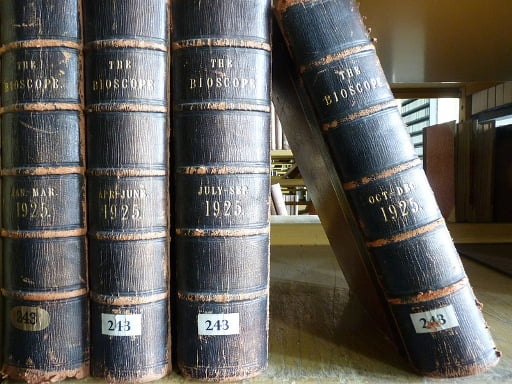
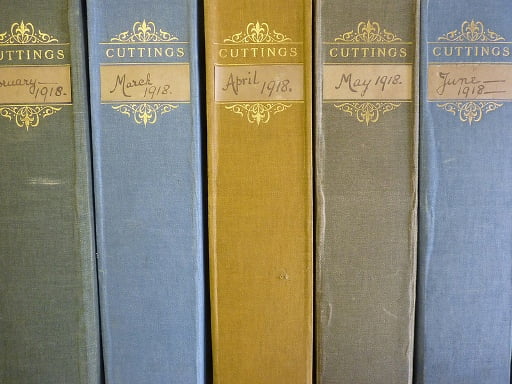



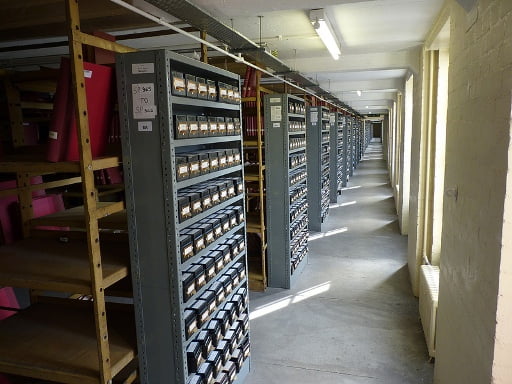
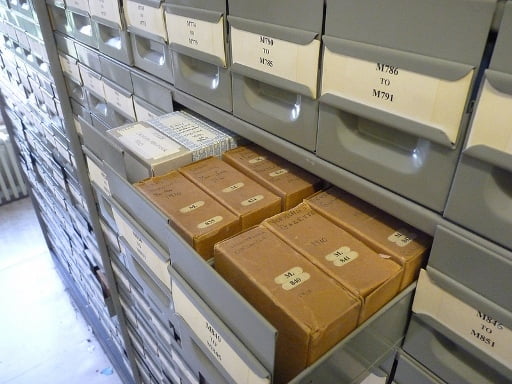
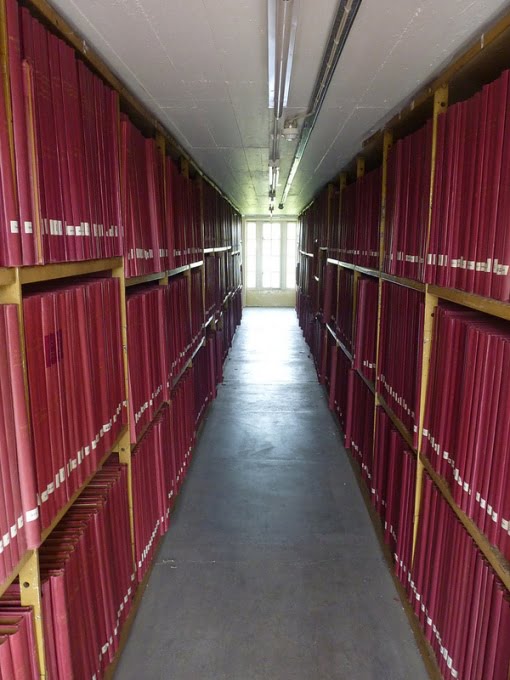


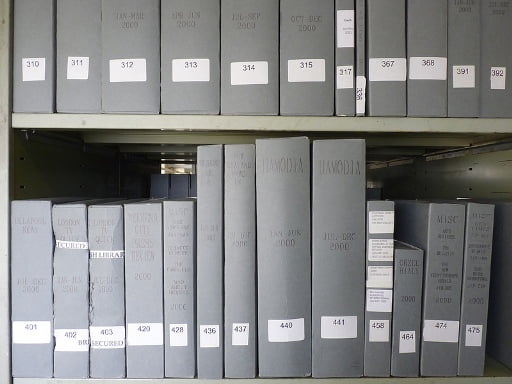
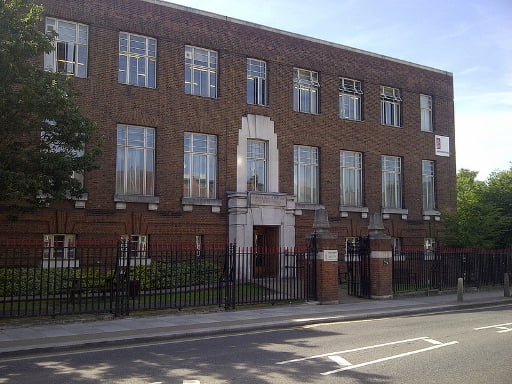
What about the wonderful vestibule with its imposing art deco decoration ? Can that not be saved for the nation ?
Digitisation has its drawbacks too.
The opening at St Pancras of what will be called the News and Media Reading Room (i.e. the replacement for Colindale) has been announced for March 2014. See http://www.bl.uk/reshelp/findhelprestype/news/newspapermoves/index.html.
As it says in the FAQs on that link, the land on which Colindale building sits has been sold to developers Fairview Homes,
So glad that you have taken these photographs Luke, they are an important record of the place. Some evocative images. Do you know if there are any art project charting the end of the archive at Colindale? Seems like there should be.
Thanks Sam. The site is being officially documented in various ways, though I don’t know about anything that could be described as an art project. My snaps were unofficial, but the place and time were so visually eloquent that I just had to make my own record, and share it.
Visiting Colindale was like travelling back through time – you could live in the 19th century and explore the lives of people long gone and find out about events and affairs that mattered to them, and can still affect us today. I discovered and printed off a piece at Colindale about a 3-mile cave system in South Wales, beneath the coal measures, found during the 1830s, which is no longer known about, but in a sufficiently detailed report for me to be able to follow through – with a view to reopening a hitherto lost part of the natural world. I also found at Colindale a single report, in a bound volume, in just one newspaper title, of the Dowlais ironmaster, Josiah John Guest, single-handedly standing down a 19th century mass insurgency of armed ironworkers and coal miners, faced by a sizeable armed military contingent, avoiding untold bloodshed in the process, but, significantly, not fully reported elsewhere.
But, really, more than the building at Colindale and its amazing storehouse of knowledge, which is beautifully captured in your pictures above (having been on a guided tour of the facilities myself, in November 2010), it has been the freedom and ease of access to such a large and diverse collection of published material that has been the true value of having a dedicated National Newspaper Library.
Can I suggest that the new holding area for newspaper titles at St Pancras is made sufficiently large that when readers call down items from Boston Spa they can often be kept in London for a period of around three to six months, to help avoid newspapers having to be sent back and forth along the motorways? Sometimes you have to revisit the same volumes to complete a research project. Other times, such as during the 20th century, daily titles were bound with a separate volume for each month, potentially wreaking havoc with any ‘maximum ordering’ limit, but generally well-served by the use of wooden trolleys!
Although Colindale, which survived the Blitz, is being left behind through practical considerations, it would seem very important that the ability for readers to travel through time, where the research takes them, through popular and well-read material or obscure and rarely-seen titles, is not lost with the change, but enhanced by it.
Enhancing time-travel is our mission.
My first visit to Colindale was about 1990. I had just learnt to drive, and I had a London A-Z, so off I set from Milton Keynes in a clapped out Chrysler Avenger to get there for 10am. Nearly 3 hours later I arrived. At Collingdale Ave, near Erith & Bexleyheath. I had gone to the end of the M1 and taken the North Circular westwards to get there. Once I realised the double “L” error, it was easier to complete the circuit of London rather than turn back. I arrived at about 3pm to discover I would need proof of ID that I didn’t have with me. Explaining to the staff about my journey, they took great pity on me and used what ID I had to sign me in! I am a lot more organised now……! Good luck with the move, and I hope to see the papers I am interested in digitised soon! (Woburn Sands, hint hint…)
Roy Greenslade has written this piece on Colindale for The Guardian:
http://www.theguardian.com/media/2013/nov/06/farewell-to-colindale-once-my-home-from-home-after-81-years
Another valedictory article is this piece by Darren Boyle in Press Gazette:
http://www.pressgazette.co.uk/national-newspaper-library-colindale-closing-friday-after-82-years
There is a video piece on the closing of the Colindale library and the new store at Boston Spa on the BBC News site. I am one of the interviewees – the other is Phil Spence, Chief Operating Officer at the British Library. The contrast between the old regime and the new is very marked (the new reading room at St Pancras, having not been fitted as yet, cannot be shown, of course).
http://www.bbc.co.uk/news/magazine-25041871
The British Library’s new reading room for news, entitled the Newsroom, opens at its St Pancras building on 7 April: http://britishlibrary.typepad.co.uk/thenewsroom/2014/03/the-newsroom.html
The British Library’s new storage building for newspapers, the National Newspaper Building (at Boston Spa, Yorkshire) opened officially in January 2015 http://britishlibrary.typepad.co.uk/thenewsroom/2015/01/into-the-void.html. The former newspaper building at Colindale has been pulled down and will be replaced by flats.
I used the reading rooms at Colindale off and on from the 1970s, I think, but I was never fortunate enough as to be allowed to see those marvellous sights backstage. Gorgeous photos – THANK-YOU! Readers were kept resolutely OUT .
But there were several good things there which have not travelled back to St Pancras: first the amount of really useful reference material on the shelves; then the card indexes, which were wonderfully informative, and finally, the big photocopy machines which allowed a full page reproduction newspaper broadsheet size, and legible! Online hurts the eyes terribly, and the complexity of trying to get a whole column on paper in one legible size is heartbreaking! I feel like screaming sometimes in the Newsroom, the online system is so obtusely unhelpful. Also, Colindale was busy but quiet, with everyone intently at work – the new Newsroom is often disrupted by ‘readers’ who are NOT intently working on newspapers, and by a particular member of staff in the room below who I think must be aurally challenged, and shouts answers to readers’ questions, so that EVERYONE has to hear the answer! The architecture lends itself to disruption! I did not realise how lucky we were at Colindale until I had to use the new Newsroom.
Was there ever a list of the books on the open shelf in the main catalogue room at Colindale? I really miss those Victorian press guides, which you could work through to work out the publishing & editing history of whatever journal you were researching. Where are they now??? Can they be found online??? Where can they be used off-shelf?
I’m glad that you like the photos. Colindale certainly had some charm, but it was a disaster in terms of preserving newspapers – no temperature or humidity controls, and all those bound volumes standing upright when they should have been laid horizontally. They are so much better off in their new home in Boston Spa. I’m sorry that you are not happy with the Newsroom: others are. I shall reply to your specific questions by email.